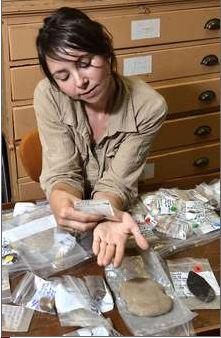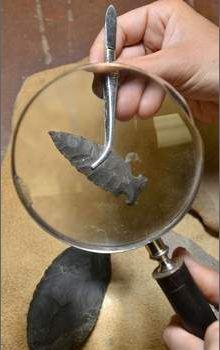Archaeologists seek answers at latest Idaho excavations
Researchers dig fossils that may be 13,000 years old
Eric Barker
Source - http://durangoherald.com/article/20120819/NEWS03/708199912/-1/s#
Archaeological digs along the lower Salmon and North Fork Clearwater rivers are expanding what scientists know about the prehistory of the Pacific Northwest and may help revolutionize what is known about the first people to inhabit North America.

Laura Longstaff, a graduate student at the University of Idaho, catalogs artifacts uncovered at an archaeological dig near Kelly Creek in the Clearwater National Forest in north-central Idaho. - STEVE HANKS/Lewiston (Idaho) Tribune

Researchers at the University of Idaho are studying a number of artifacts, ranging from 12,000 to 200 years old found at a dig site on Kelly Creek, such as this spear point. The artifacts include arrow and spear points, fishing tools, scrapers and tools used to make other tools. STEVE HANKS/Lewiston (Idaho) Tribune
VIDEO = Students working at an archaeological site near Coopers Ferry, Idaho, have made a series of videos about the work that can be viewed at www.youtube.com/user/CoopersFerrySite.
To a large extent, that revolution already is under way. Recently published discoveries at Paisley Caves in south-central Oregon knocked holes into a long-held theory about the peopling of the New World.
And an excavation at Coopers Ferry, near Cottonwood along the lower Salmon River, and another dig near the confluence of Kelly Creek with the North Fork Clearwater River, may bolster a competing theory about who the first Americans were and teach us about the way they lived.
In 1997, Oregon State University archaeologist Loren Davis discovered a cache of stone tools at Coopers Ferry that, according to radio carbon dating, are more than 13,000 years old.
This summer, and in future years, he and his students are expanding the site, which probably was a seasonal village, and looking for more artifacts. As they slowly work their way down through time and layers of earth, they hope to confirm the site holds clues that are among the oldest evidence of humans on the continent.
Items in the cache included projectile points, tools for making stone points and raw materials for making the tools.
“Sometimes, we talk about it in terms of ... an equipment locker somebody basically put in the ground, and they could come back and open it up and use it,” Davis said. “To be able to envision the use of the landscape from this place through the kinds of tools and features we see in the ground, that is exciting.
“If ultimately, the bottom part of the site ends up being 13,000 calendar years old or older, it will be as important as Paisley, if not more important because Paisley Caves doesn’t have a lot of artifacts. It’s pretty lean on artifacts,” he said.
But Paisley has proved to be rich in important data. Davis is part of a team that meticulously documented human use at the site dating back more than 14,000 years.
They discovered fossilized human feces known as coprolites more than 14,300 years old and a different style of projectile points, known as Western stemmed points, that are nearly 13,000 years old. The dates are important because the coprolites are older than any Clovis points found on the continent. While the stone points are not as old, they represent a different technology than Clovis points.
A debated theory says the Clovis people crossed a land bridge between northeastern Asia and North America, and proceeded south from present-day Yukon to Alberta, Canada, and into Montana through a corridor between ice fields.
They made distinctive projectile points, which were first discovered near Clovis, N.M., and have since been found in many places east of the Rockies. According to the “Clovis First” theory, these people were the first on the continent, and the ancestors of all Native Americans.
Under that theory, all other styles of stone points descended from the Clovis tradition. But the evidence at Paisley, where Western stemmed points were discovered and no Clovis points were found, indicates otherwise.
“We keep digging holes in the landscape down to the time period that should contain Clovis and we can’t find any, so the question is where are they?” Davis asked. “Maybe we already found them and they are not Clovis peoples. They are Western stemmed peoples and they truly represent a different but contemporaneous tradition.”
Western stemmed points have been found throughout the Northwest and the style correlates closely but not exactly to a style of weapons made by early people in northeastern Asia. Dating them to 13,000 years ago represents another problem for the Clovis theory, Davis said. At that time, ice sheets would have blocked the theorized route of the Clovis, but the West Coast of the continent would have been free of ice.
“Clovis people may have indeed come down through the ice-free corridor, but later, and they may have encountered a population in the West that was already established and holding down ground.”
At Kelly Creek, University of Idaho archaeologist Lee Sappington unearthed stone tools ranging from 12,000 to just a few hundred years old.
“Where we got deep, we get dates in the range of (8,000, 10,000), 11,000 years and right down to contact with the gravel where the river used to be, right around 12,000 (years),” he said. “In the whole Clearwater drainage, the heart of Nez Perce country, the absolute oldest site is right there at the casino at Hatwai and – give or take 100 years – this is just as old, and it might be a little older.”
Artifacts uncovered include projectile points, stone knives and scrapers, fishing weights and tools called shaft abraders, which were used to make arrows and darts. The site probably was more of a camp than a village, but it was used over and over again for many generations.
“Based on our dates and the types of tools we are finding, people have been going to the site for the last 10,000 years, hunting and working on their tools,” said Laura Longstaff, a graduate student who worked on the dig and is writing a thesis about it. “We have a lot of debris that is left over from when they were flaking their tools, so they spent a lot of time there just working on their tools and making them.”
She will try to interpret the artifacts, when and where they were found, to paint a picture about the people who left them and how they lived. The dig uncovered tools made from a wide variety of sources, almost none of it local, which may speak to the distances people traveled to get there.
“We have sources from Montana, Oregon and southern Idaho, so it was definitely a known stopping place for people,” Longstaff said. “They communicated it to their children or to their friends or other bands or tribes, so it was kind of a place that was on the map.”
Many of the points and scraping tools have tested positive for animal protein, indicating they were used to kill or process game. Lab work indicates the people hunted small game like rabbits and large animals such as moose and bison.
The site is near the Kelly Forks Work Center, and the dig was funded by the U.S. Forest Service. Sappington said it’s unique because it is remote, most of it hasn’t been disturbed by past development and it is not going to be destroyed by something like a highway or a road.
Many times, development leads to archaeological discoveries and the sites are excavated quickly before the artifacts are destroyed. In this case, Sappington said what wasn’t uncovered will be preserved.
“We are trying to get as much as we can out of it,” he said. “It’s the oldest site on the North Fork, the artifact styles are the oldest, the radio carbon dates are the oldest, it’s way remote, so it’s an area we don’t know much about.”